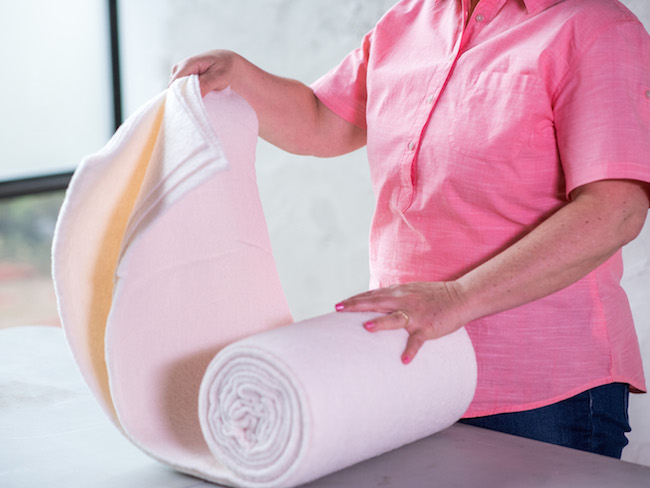
Batting seems like it ought to be a stress-free topic. After all, its entire job is to make things soft and comfy. Yet choosing the right one for your project can be totally confusing. There’s cotton versus polyester, tons of different brands, issues like fiber content and loft — the list goes on and on. Luckily, these tips provide the insight you need to navigate the batting aisle like a total boss.
1. Decide What Size to Buy
Batting comes prepackaged for standard crib-, twin-, full-, queen- and king-size quilts, but you can also buy it off the bolt in your own custom size. This option requires you to either get your custom size cut at the store or cut it yourself at home. While it adds an extra step, if you quilt a lot off-the-bolt can be a more economical (and convenient) choice in the long run.
2. Look at Fiber Content
The most common quilt batting is made of cotton or polyester, but wool, silk, bamboo or a poly-cotton blend are all fair game. Batting also comes in blends that are organic (recommended for baby quilts) or made from recycled fibers.
The good news: fiber’s mostly about personal choice, so there’s really no right or wrong here. But there are a few things to consider. Cotton, wool, silk and bamboo battings all shrink to some degree, and the packaging will tell you how much. (This is why you want it to be a bit larger than your quilt top when forming a quilt sandwich).
Cotton is the least expensive option and is super comfortable, and its heavy weight might surprise you. Wool and silk are both breathable and lightweight, making them prime for summer quilts. And bamboo is somewhere in the middle — it’s still breathable, but heavier than wool or silk and more lightweight than cotton.
3. Check the Loft
Loft is basically a fancy way of saying thickness. If you go for high-loft batting, the lines of your quilting will be more visible and the quilt will be puffier overall. Low-loft batting gives a flatter finish, which is great if you want to show off the piecing more than the actual quilting lines.
4. Try Different Brands

Quilters are definitely a loyal bunch, and most have a favorite batting brand or two. If you’re a newbie, go ahead and experiment, but also feel free to lean on more experienced quilters for recommendations. Warm & Natural batting is known for creating a soft, crinkled finish after washing that some quilters prefer, and Dream Green brand is a reliable recycled choice. There’s also Pellon battings, which come in a wide variety of fiber content and hold up nicely in the wash.
5. Think About Your Machine
Professional longarm quilting machines can handle pretty much any batting you can buy. But if you’re using a domestic sewing machine, you might have an easier time with lower loft — especially if your project is on the large side. The bulk of large batting cuts, combined with thicker loft, can make it a tight squeeze to fit your basted quilt through the neck of your machine, and that’s just asking for problems.
Good to Know: For more info on completing large projects on an everyday sewing machine, check out our online class Quilting Big Projects on a Small Machine.
Fusible batting is great for small quilting projects. It can be ironed to temporarily secure it into the middle of a quilt, which will save you time basting.
6. Choose Scrim for Stability
“Scrim” describes a light layer or grid of woven fibers added to some cotton battings. It acts as a stabilizer and helps to hold the batting together while quilting. This can be a good safeguard if you’re just starting out, or if you prefer a design with wider spacing between quilting lines. If you use a cotton batting without scrim, you’ll need to keep your quilting lines close together so the fibers don’t separate in the wash.
7. Know Bonding and Bearding
Bonded quilt battings contain a type of glue or bonding adhesive, which means the batting may become looser once the quilt is washed. This usually requires close quilting lines to make sure your quilt holds up over time.
Pro Tip: Some battings specify an optimal quilting distance between rows of stitches. Take a look at your quilting pattern and use this info to your advantage.
There are two types of bonding: thermal and resin. Thermal bonding is made by adding a fine layer of low-melt polyester scrim, then applying heat. The low melt polyester melts and forms a light barrier on either side of the batting. Resin bonding is made by adding a glue-like substance to both sides of the batting that helps hold all the fibers together.
Bearding refers to wispy fibers that eventually seep out of the quilt top, and is something to avoid. This shedding is very annoying, and a good reason to go with a high-quality quilt batting from the start.
Pro Tip: A thermal bonded batting isn’t as resistant to bearding as a resin bonded batting. However, it withstands washing better than a resin bonded batting.
8. Coordinate Colors
Batting comes in natural, bleached and black. Typically, you should use bleached batting in very light quilts, natural batting in quilts with predominantly cream or medium value colors, and black batting in predominantly dark quilts. This will keep any bearding camouflaged.
There’s a lot to consider when choosing batting, but in the end it’s up to your personal preference. Determine what you want your quilt to look like and feel like, do your research and you’ll have a gorgeous project.
Very informative!
Very Helpful Thank you
Suggestion for batting for baby quilt?
Your advice is exclusively for machine quilting. Some attention to what works for hand-quilting would be good.
Really love your website, you are a wealth of knowledge, thank for the post!